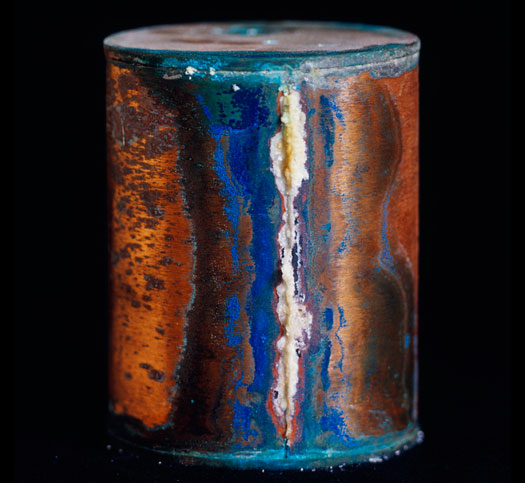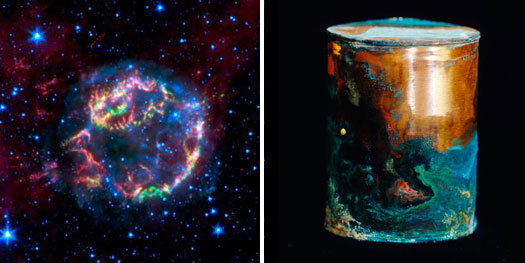They were given full military honors, including a twenty-one gun salute. Lost to time, with no identifiable descendants, the ceremony was attended by thirty people.
The soldiers were among the 3400 mentally ill patients who had lived and died in the mental asylum there (and which was later the location for the film One Flew Over the Cuckoo’s Nest). They had fought in wars that stretch back to the very foundations of America: the Indian Wars, the Spanish-Mexican War and the Civil War, as well the conflagration that ushered in the twentieth century, World War I.
To honor them, along with their fellow asylum internees, and in recognition of Memorial Day, we re-publish our original post about the fate of their ashes.

David Maisel, Library of Dust 387, 2005, C-print, 64 x 48 inches, courtesy of Von Lintel Gallery and the artist
From 1913 to 1971, 3400 mentally ill patients were cremated on the grounds of the Oregon State Hospital. Their remains were sealed in copper canisters. The canisters were stored in the hospital’s basement until the 1970s when they were moved to a memorial vault underground. The vault was subjected to periodic floods. In 2000 they were removed from their institutional crypt, placed on plain pine shelves in a storeroom, and were left virtually forgotten until David Maisel heard of their existence and photographed them.
What struck me when I first saw Maisel’s photographs at the Von Lintel Gallery was their wild, unholy color. It was as if the canisters were in bloom: ablaze with cadmium and magenta, azure and sunburst yellow, desert ochre and emerald green. Some had foamy white rivulets that slipped across the coppery sheen or bubbled outwards like lava. The colors of the canisters were so intensely vibrant as not to seem real.
But real they are. They had been soldered shut with seams of lead. Leaked traces of the human remains, a mixture of phosphates, calcium (from the bones) and sulfates, with smaller percentages of potassium, sodium and chloride (the chemistry that makes up from ashes to ashes, dust to dust) combined with the corroding acid in the groundwater to form secondary mineral deposits. From the over five thousand of these unclaimed canisters, Maisel selected 110 to photograph. He worked on site, in a temporary studio using only natural light.
I have witnessed human death only once (it was the immediate aftermath rather then the actual moment of expiration). There was no question to my mind that a transmigration had taken place: at one moment there was a full person, with his individual family history, his own distinct web of dreams, disappointments, loves and losses. And then it was all gone. A window had opened, something had left, and then the window had closed. What remained was a body, empty and somehow lighter.
Standing in front of these large-scale photographs, as I became accustomed to the visual impact of their astonishing color, the meaning of these images grew. Each canister held the remains of a human body, an unknown person who had been labeled mentally ill, who had been locked away in an asylum, and who after death had been left unclaimed for years, stacked on a shelf. These canisters held significance far greater than simply being beautiful objects.
The gallery installation didn’t make this clear, and it’s a failing. Unknowing visitors, I was told, first think these are images of bullets, paint cans or corroded batteries. When they are told what they really are, most are stunned into silence.
I learned about the context and history of these photographs after reading through the handsomely produced and expensive catalogue, Library of Dust, which, I am relieved to say, does not make the same mistake as the exhibition. The book is dedicated to the patients of the hospital and Maisel, in its postscript, writes that “through the creation of an archive of the dead and forgotten patients from the Oregon State Hospital, I am seeking to give those who lived with mental illness a presence that encourages their existence in ways that were impossible in their lifetimes.” His project, then, is an enquiry into the memory of a forgotten history and its eventual recovery.
As Michael S. Roth explains in his admirable catalogue essay, the asylum was built in Salem, Oregon in 1883 and expanded in 1913. The expansion plans necessitated more land and the plot that was selected was the Asylum’s own cemetery. The state decided to exhume the bodies buried there and cremate them on site. The incinerator was given the name “Steiner’s Chimney” in mordant dedication to the superintendent of 1910 (presumably when the plans were being drawn up). Steiner’s Chimney was located, Roth notes, just a few yards away from the actual wards.
A crematoria built on the same ground as the inmates. Smoke from the dead rising from within eyesight of imprisoned people living just a few yards away: a haunting precursor of what was to occur in the industrialized factories of death under the Third Reich. This parallel is never mentioned in either the catalogue nor the exhibition but it hovers over the entire project like an unacknowledged dark shadow.
Asylms in the mid-nineteenth century had been places dedicated to the moral treatment of their patients. This included conversation, a structured routine, exercise and diet. But as the century wore on, and as society became more dedicated to the efficiency and productivity of its population, the treatment of the “insane” (a broad and sweeping category) increasingly shifted from the therapeutic to, as Roth puts it, something closer to custodial care. Patients were taken from their families and locked away, often against their will, sometimes for their entire lifetimes: the asylum as penitentiary. The architecture of asylums reflected this as well, changing from a “curative” style, which tried to emphasize normality, to one that was closer to jails.
As a result mental asylums became places where the insane were locked up, a place where people were banished from society, a place where those who were perceived to have lost their reason also lost their right to personal freedom. They became places of fear and madness. Milos Foreman’s One Flew Over the Cuckoo's Nest (1975), based on the book by Ken Kesey, played upon these fears by upending them. In the film the asylum, like the conventional society it attacked, is seen as repressive, a set of authoritarian rules that squash and repress the individual characteristics of the patients (Nurse Ratchet’s “Gentlemen it’s medication time, medication time”, is a famous and darkly humorous line from the movie). It’s no coincidence that the location chosen to film the movie was Oregon State Hospital.
I visited such an asylum once, still in operation in London in the early 1990s. It was indeed run like a jail, with set times for bathing and eating. Patients wandered the halls during free time, some howling, others muttering, some just lost and defeated like the homeless you sometimes see on the streets. Heartbreakingly, others had simply experienced a psychotic break of some kind and their families were unable or unwilling to take care of them. Their families had persuaded the medical authorities that they were a danger to themselves or to others. Most of those in the last category could now probably be successfully treated with antidepressant or antipsychotic drugs. But once they had been committed to the asylum, their behavior, some of which would seem odd but generally normal in the outside world, was treated as evidence of mental illness. Once you were in, it was very hard to get out.
The canisters partly represent this loss of individual identity. They are stamped with ID numbers but often these numbers have been abraded into illegibility. They also had paper labels with the names of the inmates on them. Over the years, and as result of the periodic flooding, most of those had either disintegrated or were lost. We will never know whose remains are locked inside.

From 1913 to 1971, 3400 mentally ill patients were cremated on the grounds of the Oregon State Hospital. Their remains were sealed in copper canisters. The canisters were stored in the hospital’s basement until the 1970s when they were moved to a memorial vault underground. The vault was subjected to periodic floods. In 2000 they were removed from their institutional crypt, placed on plain pine shelves in a storeroom, and were left virtually forgotten until David Maisel heard of their existence and photographed them.
What struck me when I first saw Maisel’s photographs at the Von Lintel Gallery was their wild, unholy color. It was as if the canisters were in bloom: ablaze with cadmium and magenta, azure and sunburst yellow, desert ochre and emerald green. Some had foamy white rivulets that slipped across the coppery sheen or bubbled outwards like lava. The colors of the canisters were so intensely vibrant as not to seem real.
But real they are. They had been soldered shut with seams of lead. Leaked traces of the human remains, a mixture of phosphates, calcium (from the bones) and sulfates, with smaller percentages of potassium, sodium and chloride (the chemistry that makes up from ashes to ashes, dust to dust) combined with the corroding acid in the groundwater to form secondary mineral deposits. From the over five thousand of these unclaimed canisters, Maisel selected 110 to photograph. He worked on site, in a temporary studio using only natural light.
I have witnessed human death only once (it was the immediate aftermath rather then the actual moment of expiration). There was no question to my mind that a transmigration had taken place: at one moment there was a full person, with his individual family history, his own distinct web of dreams, disappointments, loves and losses. And then it was all gone. A window had opened, something had left, and then the window had closed. What remained was a body, empty and somehow lighter.
Standing in front of these large-scale photographs, as I became accustomed to the visual impact of their astonishing color, the meaning of these images grew. Each canister held the remains of a human body, an unknown person who had been labeled mentally ill, who had been locked away in an asylum, and who after death had been left unclaimed for years, stacked on a shelf. These canisters held significance far greater than simply being beautiful objects.
The gallery installation didn’t make this clear, and it’s a failing. Unknowing visitors, I was told, first think these are images of bullets, paint cans or corroded batteries. When they are told what they really are, most are stunned into silence.
I learned about the context and history of these photographs after reading through the handsomely produced and expensive catalogue, Library of Dust, which, I am relieved to say, does not make the same mistake as the exhibition. The book is dedicated to the patients of the hospital and Maisel, in its postscript, writes that “through the creation of an archive of the dead and forgotten patients from the Oregon State Hospital, I am seeking to give those who lived with mental illness a presence that encourages their existence in ways that were impossible in their lifetimes.” His project, then, is an enquiry into the memory of a forgotten history and its eventual recovery.
As Michael S. Roth explains in his admirable catalogue essay, the asylum was built in Salem, Oregon in 1883 and expanded in 1913. The expansion plans necessitated more land and the plot that was selected was the Asylum’s own cemetery. The state decided to exhume the bodies buried there and cremate them on site. The incinerator was given the name “Steiner’s Chimney” in mordant dedication to the superintendent of 1910 (presumably when the plans were being drawn up). Steiner’s Chimney was located, Roth notes, just a few yards away from the actual wards.
A crematoria built on the same ground as the inmates. Smoke from the dead rising from within eyesight of imprisoned people living just a few yards away: a haunting precursor of what was to occur in the industrialized factories of death under the Third Reich. This parallel is never mentioned in either the catalogue nor the exhibition but it hovers over the entire project like an unacknowledged dark shadow.
Asylms in the mid-nineteenth century had been places dedicated to the moral treatment of their patients. This included conversation, a structured routine, exercise and diet. But as the century wore on, and as society became more dedicated to the efficiency and productivity of its population, the treatment of the “insane” (a broad and sweeping category) increasingly shifted from the therapeutic to, as Roth puts it, something closer to custodial care. Patients were taken from their families and locked away, often against their will, sometimes for their entire lifetimes: the asylum as penitentiary. The architecture of asylums reflected this as well, changing from a “curative” style, which tried to emphasize normality, to one that was closer to jails.
As a result mental asylums became places where the insane were locked up, a place where people were banished from society, a place where those who were perceived to have lost their reason also lost their right to personal freedom. They became places of fear and madness. Milos Foreman’s One Flew Over the Cuckoo's Nest (1975), based on the book by Ken Kesey, played upon these fears by upending them. In the film the asylum, like the conventional society it attacked, is seen as repressive, a set of authoritarian rules that squash and repress the individual characteristics of the patients (Nurse Ratchet’s “Gentlemen it’s medication time, medication time”, is a famous and darkly humorous line from the movie). It’s no coincidence that the location chosen to film the movie was Oregon State Hospital.
I visited such an asylum once, still in operation in London in the early 1990s. It was indeed run like a jail, with set times for bathing and eating. Patients wandered the halls during free time, some howling, others muttering, some just lost and defeated like the homeless you sometimes see on the streets. Heartbreakingly, others had simply experienced a psychotic break of some kind and their families were unable or unwilling to take care of them. Their families had persuaded the medical authorities that they were a danger to themselves or to others. Most of those in the last category could now probably be successfully treated with antidepressant or antipsychotic drugs. But once they had been committed to the asylum, their behavior, some of which would seem odd but generally normal in the outside world, was treated as evidence of mental illness. Once you were in, it was very hard to get out.
The canisters partly represent this loss of individual identity. They are stamped with ID numbers but often these numbers have been abraded into illegibility. They also had paper labels with the names of the inmates on them. Over the years, and as result of the periodic flooding, most of those had either disintegrated or were lost. We will never know whose remains are locked inside.

Image from the Spitzer Telescop, NASA. David Maisel, Library of Dust 1211, 2005, courtesy of Von Lintel Gallery and the artist
If all this seems grim, take a look at the canisters again. Their swirl and surge of color reminds me of nothing less than the spectacular images taken through NASA’s Spitzer telescope: the visual identity of the canisters miraculously mirrors that of the universe itself. And yet each rivulet and blossom of color are as distinctive and as personal as the human remains held within. It’s as if the mysterious something that leaves the body at the moment of death, often called the soul, is trying to escape. What's left is evidence of extraordinary beauty.
If all this seems grim, take a look at the canisters again. Their swirl and surge of color reminds me of nothing less than the spectacular images taken through NASA’s Spitzer telescope: the visual identity of the canisters miraculously mirrors that of the universe itself. And yet each rivulet and blossom of color are as distinctive and as personal as the human remains held within. It’s as if the mysterious something that leaves the body at the moment of death, often called the soul, is trying to escape. What's left is evidence of extraordinary beauty.



Comments [21]
03.08.10
12:13
03.08.10
02:17
03.08.10
05:23
03.08.10
06:23
Well done.
03.08.10
07:58
03.09.10
09:37
03.09.10
12:36
03.09.10
01:09
03.09.10
04:24
Thank you.
03.10.10
12:29
03.10.10
10:44
03.11.10
12:13
03.11.10
01:06
amazing project... as if someone has captured the colors of death in a glimpse of a second... really amazing..
03.12.10
05:20
03.15.10
11:13
03.25.10
03:46
06.23.10
05:49
07.02.10
11:35
09.22.10
11:08
02.16.11
10:32
These dead were once living and the finding and treasuring of them is a true homage to their lives. They are holy, they were the forgotten people. Their remains beg to be seen, as their souls have long since ascended.
Thank you for this glimpse of the past.. may it never be repeated.
Susan Berner
05.24.11
04:38